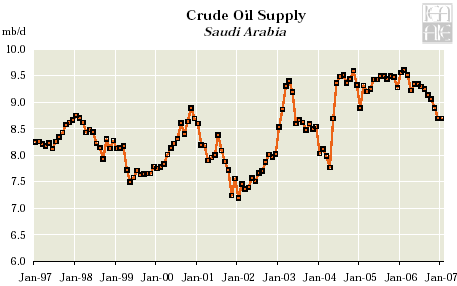

 |
Saudi Arabia |
|---|---|
 | |
 Ghawar: an estimate of remaining oil reserves and production decline (Part 2 - results), posted by Euan Mearns in The Oil Drum [2007 April 27]
Ghawar: an estimate of remaining oil reserves and production decline (Part 2 - results), posted by Euan Mearns in The Oil Drum [2007 April 27]
"The ravages of 50+ years production on reserves in Northern Ghawar are there for all to see on the Linux oil saturation model (Figure 5, Part 1). Northern Ghawar is in a heavily depleted state and will shortly enter a period of irreversible decline. However, despite being around 88% depleted, regions like N ' Ain Dar still contain a significant amount of recoverable dry oil - about 1.5 billion barrels in the case of N 'Ain Dar. This is sufficient to support 500,000 bpd production for a few years yet (183 million barrels per year)."Saudi Arabian oil declines 8% in 2006, posted by Stuart Staniford in The Oil Drum [2007 March 2] "The implied decline rate through the year [2006] is 8% ± 0.1%.... As far as I know, there are no known accidents or problems that would explain any restrictions on oil supply, and the Saudis themselves have maintained publicly that their production is unproblematic and they intend to increase it. Doubts Raised on Saudi Vow for More Oil, New York Times, by Jeff Gerth [2005 October 27] "Last spring, the White House publicly embraced plans by Saudi Arabia to increase its oil production capacity significantly. But privately, some officials and others advising the government are skeptical about some of those Saudi forecasts. " Twilight in the Desert: The Coming Saudi Oil Shock and the World Economy, available May 2005 "The most critical question facing the world energy market is whether Saudi Arabia can substantially increase its oil production to meet rising world demand in the years ahead. Sparked by personal observations of Saudi oil wells which led him to suspect that some Saudi fields were in decline, Matt Simmons has created a compelling case that Saudi Arabia production will soon reach an apex, after which its production will decline and the world will be confronted with an immense and potentially catastrophic oil shortage. The factual basis of the book is over 200 technical papers published over the last 20 years which individually detail problems with particular wells or particular fields, but which collectively demonstrate that the entire Saudi oil system is “old and fraying.” Based on his analysis, Mr. Simmons asserts that sudden and sharp oil production declines could happen at any time. Even under the most optimistic scenario, Saudi Arabia may be able to maintain current rates of production for several years, but will not be able to increase production enough to meet the expected increase in world demand. Eventually, the reckoning day will come and the world economy will be confronted with a major shock that will stunt economic growth, increase inflation, and potentially destabilize the Middle East. Indonesia and Oman - their declines will outweigh Saudi increase, by Bill Powers, Financial Sense Online [2004 August 1] "[Oman oil field] Yibal’s life cycle is important because many of the same EOR techniques used on the field have also been employed on the world’s largest oil field, Saudi Arabia’s Ghawar. In a February 2004 symposium at the Center for Strategic and International Studies in Washington, DC, energy investment banker Matt Simmons confronted two Saudi Aramco officials with the suggestion that the advanced recovery techniques used at Ghawar, which produces approximately 4.5 million bbl/d, have created an illusionary “fountain of youth” for the field. Simmons’ theory, which is based on the review of over 200 technical papers, suggests that the combination of horizontal drilling and water flooding has allowed Aramco to keep Ghawar production flat at the expense of future production. More importantly, Simmons believes that Ghawar’s rising water cuts indicate that the field is about to head into terminal and irreversible decline. Should Ghawar’s water cuts keep rising similar to Yibal’s; the world will soon experience triple digit oil prices" The Saudi Arabian Oil Miracle, by Matt Simmons at The Center for Strategic & International Studies, Washington, DC [2004 February 24] "Everyone's 'plug' factor for future energy growth is Saudi Arabia's ability to increase its oil flow. If this premise is wrong, the world is in for a 'nasty shock'." The New Yorker's Annals of National Security tells about a King's Ransom: "[T]he National Security Agency['s] ... intercepts of conversations between members of the Saudi Arabian royal family... depict a regime increasingly corrupt, alienated from the country's religious rank and file, and so weakened and frightened that it has brokered its future by channelling hundreds of millions of dollars in what amounts to protection money to fundamentalist groups that wish to overthrow it..." by Semour Hersh [2001 October 22] Read an informative article about "Geopolitics and Energy in the Middle East." [1999 September 15] Read "The Tent of Saud" -- a Commentary on the political situation in Saudia Arabia from Worth Magazine [1995 November] Oscar For An Oilfield, by Brainerd S. Bates [1973 November/December] "Ghawar, an underground structure 150 miles long, is the largest—and most productive—oil field in the world."
For geographic, government and economic information about Saudi Arabia, consult the US Energy Information Agency. |
 |
|
 © 1994-2011 • Ecotopia © 1994-2011 • Ecotopia |
• contact info |